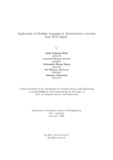| dc.contributor.advisor | Ashraf, Faisal Bin | |
| dc.contributor.author | Ridi, Sadia Sobhana | |
| dc.contributor.author | Tandra, Jannatul Farzana | |
| dc.contributor.author | Emon, Mahmudul Hasan | |
| dc.contributor.author | Mahmud, Md Ridwan | |
| dc.contributor.author | Tabassum, Sumaiya | |
| dc.date.accessioned | 2023-10-12T09:07:21Z | |
| dc.date.available | 2023-10-12T09:07:21Z | |
| dc.date.copyright | ©2022 | |
| dc.date.issued | 2022-09-29 | |
| dc.identifier.other | ID 18301279 | |
| dc.identifier.other | ID 19101097 | |
| dc.identifier.other | ID 19101098 | |
| dc.identifier.other | ID 19101104 | |
| dc.identifier.other | ID 19101113 | |
| dc.identifier.uri | http://hdl.handle.net/10361/21791 | |
| dc.description | This thesis is submitted in partial fulfillment of the requirements for the degree of Bachelor of Science in Computer Science and Engineering, 2022. | en_US |
| dc.description | Cataloged from PDF version of thesis. | |
| dc.description | Includes bibliographical references (pages 30-31). | |
| dc.description.abstract | Brain-computer interface (BCI) spellers enable severely motor-impaired people to
communicate through brain activity without the use of their muscles. Our brains
precisely predict what we will think. If a human-readable character can be identified
by its appearance, our issues may be resolved. Currently, human, machine, and
brain communication based on machine learning is highly believable. In this study,
we intend to employ the non-invasive brain stimulation technique, often known as
EEG, for the treatment of these individuals. A Braincomputer interface system
based on electroencephalography provides the optimal solution to this issue. It establishes
a link between the brain and the computer system, allowing brain waves
to control our actions. The objective is to determine if a person is paying attention
by recognizing characters from a dataset of P300, which is an event-related potential
(ERP) component, using a BCI design. If a character is identified as a person
paying attention, the data is labelled as target class; otherwise, the data is displayed
as non-target. Our study has resulted in a number of Machine Learning strategy
techniques. In this study, we analyzed the performance of four different types of
Machine Learning Algorithms, including Logistic Regression (LRR), Random Forest
Classifier, AdaBoost classifier, and XGBoost Classifier, to determine the most
accurate algorithm. Custom CNN achieved the highest accuracy among classifiers,
at approximately 88.46%. | en_US |
| dc.description.statementofresponsibility | Sadia Sobhana Ridi | |
| dc.description.statementofresponsibility | Jannatul Farzana Tandra | |
| dc.description.statementofresponsibility | Mahmudul Hasan Emon | |
| dc.description.statementofresponsibility | Md Ridwan Mahmud | |
| dc.description.statementofresponsibility | Sumaiya Tabassum | |
| dc.format.extent | 42 pages | |
| dc.language.iso | en | en_US |
| dc.publisher | Brac University | en_US |
| dc.rights | Brac University theses are protected by copyright. They may be viewed from this source for any purpose, but reproduction or distribution in any format is prohibited without written permission. | |
| dc.subject | Textual representation | en_US |
| dc.subject | Brain signal | en_US |
| dc.subject | BCI | en_US |
| dc.subject | EEG | en_US |
| dc.subject | LRR | en_US |
| dc.subject | CNN | en_US |
| dc.subject | ERP | en_US |
| dc.subject.lcsh | Brain--Computer simulation | |
| dc.subject.lcsh | Behavioral assessment--Data processing | |
| dc.title | Application of machine learning in attentiveness detection from EEG signal | en_US |
| dc.type | Thesis | en_US |
| dc.contributor.department | Department of Computer Science and Engineering, Brac University | |
| dc.description.degree | B.Sc. in Computer Science and Engineering | |

